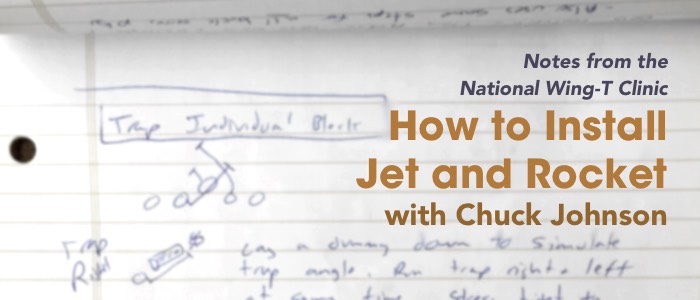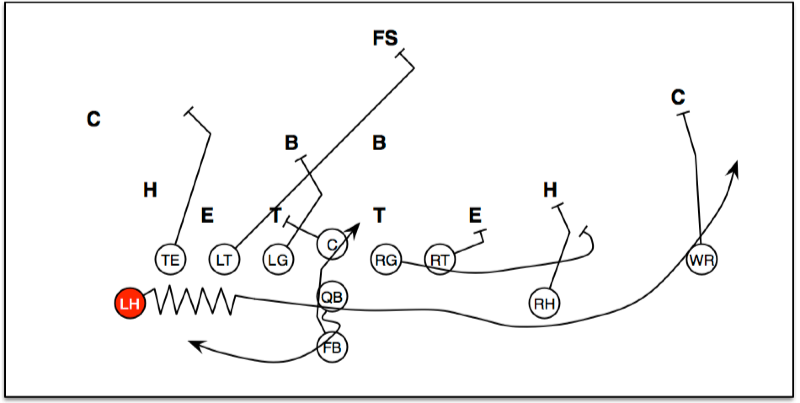Wing-T Jet and Rocket with Chuck Johnson

I wrote about Chuck Johnson’s approach to practice organization last week but didn’t go into his approach to running Jet and Rocket as that warrants a dedicated post. Chuck had a handout on jet and rocket sweep and gave his summary on why to run it:
- They are both natural complements to the Buck series
- They are great spread flank (WR / weak-side) plays
- You really only need to block two or three defenders on the play for it to be effective
- The QB under center (vs. shotgun) is in the best position to receive the snap and hand the ball or pitch it, FAST!
- The wingback position is the best starting position for the ball carrier for the timing of the motion
- Both plays hit the perimeter very fast! The ball carrier is at full speed!
- You can use multiple blocking schemes on the perimeter similar to option, i.e. stalk and stack, crack and stalk
- Jet and Rocket create better blocking match-ups for your personnel on the flank than straight Buck Sweep
I also wrote some notes on the talking he did during the clinic:
- Chuck believes it is best to run jet and rocket to the split end / weak side, and he prefers running both under center
- The faster you can get to the flank the better, and he will always pull the play-side guard
- His practice routine is a hose drill, with two hoses setup 15 yards apart and the coach standing in between. At both hoses you have a QB and backfield running the play being called. 1s and 2s will be on one hose, other backups on the other hose. Have the next QB always be kneeling and handing the ball up (simulated snap) to the QB as that is a key part of the practice repetition
- Seating the ball to the belly (3rd hand) is critical and must be coached constantly
- He also coaches “long arms” and as much depth from center as the QB can get.
- He reminded us that the FB can do a better trap fake on jet because he doesn’t need to fill for a back-side guard
- Force the flank and always work to the sideline, even if that means cutting downfield then turning out again. Jet and rocket will generally not cut back across field like buck sweep will.
- On weak side jet and rocket he sends the TE and back-side tackle on a cutoff / TD block across field. They teach them to “be a tree” and not even try to block - just get in the way. Helps avoid illegal blocks.

For example, here’s how Chuck would block a weak-side Jet Sweep to the right (Lily 28 Jet Sweep in my terminology) against an even front (4–4 or 6–2 in this case):
- Don’t bother blocking the play-side tackle.
- RH (wingback) log blocks force man - first player outside the reach block by the RT
- RT reaches to play-side and blocks the DE
- RG pulls wide and lead blocks for Jet back
- C blocks down to the left on the back-side tackle
- LG folds around C and blocks Mike backer
- LT goes to safety for cutoff block (“Be A Tree”)
- TE goes downfield for cutoff block, probably on backside corner or outside LB (“Be A Tree”)
He recommends running Rocket Sweep almost the same way, with a few tweaks:
- Make sure the running back catches the pitch behind or just outside the TE
- QB snaps the ball to his “third hand” (belly), reverse pivots 45 deg beyond the midline. Make a two-handed pitch out in front of the ball carrier. Do not let hands follow through above your chest – ball needs to stay on a flat trajectory.
- QB after the pitch snaps his hands to his outside hip then boots, always threaten the opposite flank
- Press the flank just like on jet - running back keeps working outside to the numbers. Even if contained, after working upfield past force, work back outside ASAP.
- The FB goes opposite direction (key breaker), not just a trap fake
- They have the playside tackle “reach through backer” – if he can reach around the defensive lineman that is on or shading him, they won’t even block him but have him go around and log the backer. This can sometimes get you a double-team with the tackle and WB on the force linebacker.